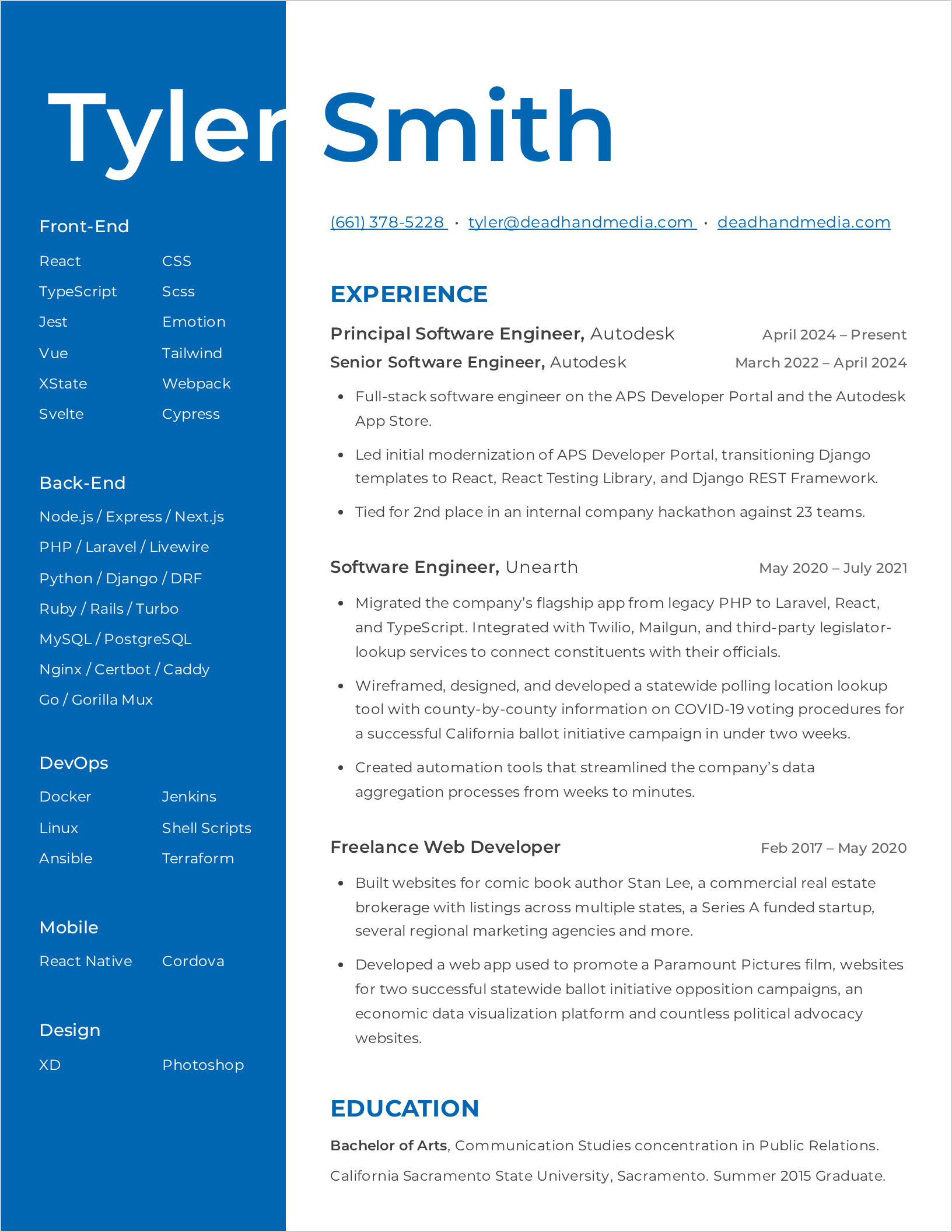This repo contains my resume, which was built using web technologies. Modern CSS is a powerful layout language that allows me to make page-wide changes much faster than I would be able to if I were using InDesign. Using web technologies also allows me to use the exact same code as a website, which you can find at resume.deadhandmedia.com. The site is mobile responsive, uses semantic markup, and takes advantage of CSS's print styling capabilities.
When code is pushed to the main branch, the build process will use Puppeteer to generate an open graph image for the website, along with a PDF and PNG file of the resume. You can see the most recently generated image of the resume below.
To run the project locally, clone the repo and run the following commands from the main project directory:
docker compose build
docker compose run --rm node npm install
docker compose upThis will build a container with Chromium and its dependencies, install the Node packages, and start the development server at http://localhost:3000. The container is only intended for local development: it simply provides a runtime to mount your local installation into. On the production server, Netlify will serve the static files from the build/ directory.
NPM will prevent the host machine from running the development server or running npm install by checking if a NOT_HOST_MACHINE environment variable is present and set to 1. This ensures better isolation between the container and host, and prevents accidental installation of packages with non-Linux binaries bundled. You can read about how I implemented this in my blog post.
If you need to install a new package, you can open a bash shell in a running container by running the following command on the host:
docker compose exec node /bin/bashOnce inside the container, you can run NPM installation commands the way that you normally would.
npm install lodash
Assets are automatically generated when the development server starts. To regenerate the assets manually, run the following command from the host machine while the container is up:
docker compose exec node npm run buildThis kicks off the node/build.js script, which saves the generated files to the build/generated directory. Generated files are not committed into version control.
When code is committed to the main branch, Netlify will run the npm run build command. This command relies on three environment variables being set in netlify.toml:
NOT_HOST_MACHINEmust be set to"1"(with quotes) to allow the script to start.NODE_ENVmust be set to"production"to tellnode/build.jsto use the Chromium executable provided by thechrome-aws-lambdapackage from NPM.AWS_LAMBDA_FUNCTION_NAMEmust be set to any value to prevent thechrome-aws-lambdapackage from emitting aCould not find expected browser (chrome) locallyerror.
The chrome-aws-lambda package provides a pre-compiled Chromium executable designed to run in a serverless environment without relying on system dependencies. When developing in the container, node/build.js uses Debian's Chromium instead.
On commits that don't require a new build (like when making edits to the README), you can add [skip ci] or [skip netlify] to anywhere in the commit message. Netlify won't build that commit until a newer commit without that string in the commit message arrives, which conserves the monthly build minutes. You can read more about this in the Netlify docs.
The open graph image features a low resolution version of the resume that replaces the text blocks with solid rectangles. The code that transforms the text blocks into rectangles lives in assets/open-graph-image.js. It works by wrapping the text blocks in solid-colored spans when the ?open-graph-image query variable is present on the URL. You can see this in action by visiting https://resume.deadhandmedia.com/?open-graph-image.
This low-resolution version of the resume is then pulled into templates/open-graph-image.ejs via iframe, which Puppeteer uses as a template for generating the final open graph image.
Platforms like Facebook cache open graph images based on the URL, and therefore won't always pick up changes made to the image.
To combat this problem, a commit ref is added as a query parameter to the end of the open graph URL. The app uses a COMMIT_REF environment variable to grab the current commit.
To use this environment variable during development, start the server with the following command:
COMMIT_REF=$(git show-ref --hash refs/heads/main) docker compose upNetlify automatically provides a COMMIT_REF environment variable at build time.
For a better development experience, LiveReload can be used to show edits in the browser without refreshing having to refresh the page. Changes to CSS, JS and EJS files are instant. Normally, EJS files would require a full server reload using Nodemon, but the current LiveReload maintainer offered a workaround in a GitHub issue that is implemented on this project. The implementation used is based on this Stack Overflow answer.

